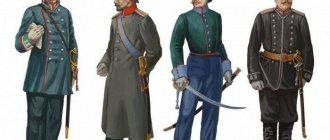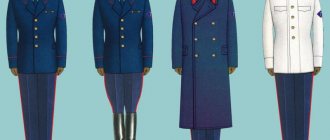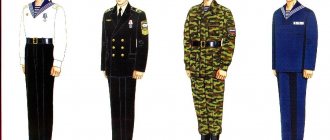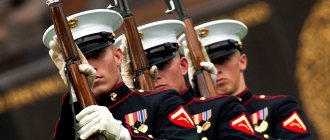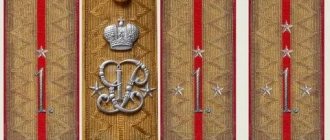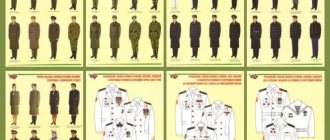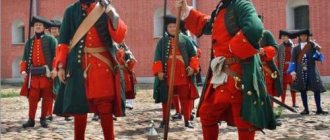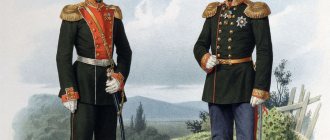Every man, especially those who served, will agree that military clothing is considered the key to the high combat effectiveness of military forces. In Russia, military uniforms always meet all the necessary requirements: they are reliable, comfortable and perform all their main functions. Today in Russia every soldier of the military forces is equipped with a military uniform. Still, uniforms are one of the important aspects of service.
Let's look at what a police officer's uniform is in Russia, what it is like, what the history was, what the main features are and the approximate price.
History of the creation and development of police uniforms
It is believed that the police appeared in Russia in 1718 by a special decree of Peter I. But long before the reign of the first Russian emperor, there was a so-called Robbery Order, which was entrusted with law enforcement and detective functions. The law enforcement officers who served in this department were called “Zemstvo yaryshki.”
They did not have a uniform in the current sense, however, it was obligatory to print two letters made of red material on their clothes - “Z” and “I”. This sign was popularly deciphered as “poisonous snakes,” which suggests that the love for “organs” in Russia arose quite a long time ago.
Apparently, even under Peter, a tradition developed according to which the clothing for police officers was a slightly modified army uniform. However, in the 19th century this trend is no longer so easy to trace. Police uniforms changed most noticeably under Alexander II and Alexander III. One way or another, pre-revolutionary policemen were easily recognizable.
It should be noted that the uniform of the gendarmes was the most dapper. Whether they can be considered police is a moot point, since they were mainly engaged in political investigation. The “dirty work” went primarily to the police officers, police officers and the already mentioned policemen, but they looked much simpler.
In 1917, the old Russian police were disbanded. It was replaced by the police - the name is new, but the functions are basically the same. It is interesting that under Soviet rule, the uniform of representatives of law enforcement agencies changed most dynamically. In the 1920s, changes were especially frequent. Subsequently, when films began to be made about this era, on the screen one could see an ordinary policeman in a characteristic white helmet.
In fact, this headdress, known as "hello and goodbye", became part of the uniform only in 1931, and its coloring was most often dark gray. White color was used in the summer, but not in all cities, but only in resorts and in the capital. Shoulder straps were not worn in those days, since they were considered an “old regime” accessory, so insignia were placed in buttonholes.
In the early 40s, the uniform of the Ministry of Internal Affairs became rather gloomy. Perhaps this was to some extent a consequence of the pre-war and then military situation. Between 1941 and 1945, ceremonial clothing was not issued at all.
Anyone can study the evolution of the police uniform, thanks to Soviet cinema. For example, if a viewer is interested in the uniform of an investigator of the Ministry of Internal Affairs in the 70s, he just needs to admire “Lieutenant Colonel Znamensky” from the popular television series.
After the collapse of the USSR, the police retained their name for a long time, and the appearance of the officers remained virtually unchanged. “Changing clothes” occurred, but they were few.
In 2011, on the initiative of Dmitry Medvedev, the long-overdue renaming of the “people's militia” into the police took place. At the same time, a plan arose to radically update the uniform. The corresponding order of the Ministry of Internal Affairs was issued in 2013. According to the developers of the new model of police clothing, they managed to significantly improve the previous uniform, making it more functional, and at the same time aesthetically attractive.
What elements does the uniform of a cadet of the Ministry of Internal Affairs consist of?
The main components of the form are:
- outerwear;
- shoes;
- hats;
- shoulder straps and stripes;
- accessories.
The range of outerwear includes shirts and trousers, skirts, jackets, and tunics. Depending on the season, the appropriate sample is used. In summer they wear clothes made of lightweight materials, and in winter they wear insulated clothes. Various shoes and boots of the established pattern are used as footwear.
Among the hats, caps and caps are distinguished. Additionally, they have matching cockades and filigree.
Shoulder straps, stripes and accessories are mandatory elements through which a cadet is identified. The field letters K are obligatory attached to everyday uniforms. There is also a similar ceremonial recognition sign: the letter K is golden. Accessories include various auxiliary elements, for example, tie clips, hairpins for women, filigree, and various emblems.
The inscription “Police” is also present on the clothes as stripes, which confirms the cadet’s attitude to the corresponding law enforcement agency. The uniform also has a patch with information about the blood type.
The main feature of the cadets' uniform is its practicality. High-quality materials are used that are characterized by increased durability. The fabrics do not fray and do not become dirty for a long time, even with daily wear. The most complete range of products in this category is presented in our online store.
New sample form
Despite the fact that the order to “change clothes” for the police was issued back in 2013, until recently, police officers in the old uniform could be seen on the streets of some cities. You can distinguish it from the new one by its predominant dark gray color. The reason for such a slow replacement of uniforms is simple - underfunding. In addition, the scale of the work must be taken into account.
As of 2022, at least 70% of all employees of the Ministry of Internal Affairs were provided with the new uniform (data on the “police itself” was not provided). In April of this year, the government reported that the “change of clothes” plan had already been completed by 95%. Thus, the canceled uniforms should finally disappear this year.
Location of stripes on the Ministry of Internal Affairs uniform
Police stripes should be positioned 80mm from the fold or shoulder seam. If there is a pocket on the sleeve, the braid will be located in its center.
- The police inscription is located 1 centimeter above the left pocket on the chest.
- Below, 1 centimeter from the red stripe on the back, is the inscription police.
- The ministry's general sleeve chevron will be installed on the left sleeve.
- On the right is a chevron, which indicates that the employee belongs to a specific department
On casual wear
According to the order, the distinctive signs for employees were replaced by a new model. In addition to the general description of embroidery, the rules for its placement on the form are determined. The distance between them, placement on the uniform and information when installing a distinctive sign on casual and formal clothing have been established.
The sleeve insignia denoting membership in the Ministry of Internal Affairs is placed at a distance of 80 mm from the upper edge of the insignia and before the stitching of the left sleeve. The remaining marks should be located at a length of 90 mm from the top edge of the patch to the top stitching point of the right sleeve.
Police chevrons are installed on a steel-colored woolen tunic or jacket. White stripes must be attached to a white shirt or blouse. Cadets wear dark blue stripes.
On the sleeve, all signs are sewn at a distance of 80 mm from the shoulder seam to the upper border of the patch.
On formal wear
The patches on the new uniform are different from the patches on the previous uniforms. Attention is paid to the patch used. For example, steel-colored signs are sewn on in the same color. On a blue tunic or women's blouse, the chevron should be the same color. Dimensions must be observed. The galloon should be in the format 120 by 75. The principle of arrangement is identical to that of any other form.
The sleeve patch is located on the output form. Embroidery is performed with multi-colored images of elements.
How does the new police uniform differ from the old uniform?
The new form has become much more convenient and practical. Compared to the previous one, it looks more dignified and solid. This is an important point, since the attitude of society towards representatives of law enforcement agencies depends on the positive perception of both their internal qualities and appearance. Therefore, the new police uniform was developed taking into account the latest fashion trends.
As a result, the uniform of the Ministry of Internal Affairs officers changed both style and color - the gray-blue clothes were replaced by a dark blue color scheme. The development of technology has made it possible to use the latest fabric samples, which are characterized by greater wear resistance and functionality, for sewing new police uniforms. In particular, a membrane coating was used, thanks to which police officers feel comfortable both indoors and outdoors.
Employees of the Ministry of Internal Affairs received new sets of summer and winter uniforms. In addition to new casual clothing, the police acquired a completely new dress uniform, which aims to emphasize the prestige of service in law enforcement agencies.
All new police uniforms were developed taking into account the weather conditions of a particular region and are designed to ensure the comfort of police officers serving both in areas with hot and temperate climates, and in cold climates, which are characterized by severe frosts. Among other innovations, police officers are offered comfortable and warm sweaters and jackets. To produce summer uniforms, fabrics with increased breathability are used.
Previously, the police provided for a transition directly from summer uniforms to winter ones. Now, in addition to summer and winter uniforms, there is also a demi-season option. In rainy weather, a police officer has the opportunity to wear a modern windproof suit made of membrane-coated fabric, whereas in the past, for bad weather, an extremely outdated raincoat was offered.
Thanks to the peculiarities of the manufacturing material and excellent workmanship, the new police uniform retains its decent appearance in any weather. A number of uniform items, including trousers and tunics, are made from worsted fabric containing wool and lycra. Thanks to this composition, the fabric is able to repel moisture and dust and at the same time practically does not wrinkle.
uniforms and insignia June 1975-June 12, 1990
By order of Ministry of Internal Affairs No. 140 of June 2, 1975.
Changes and additions have been made to the existing police uniform. Two types of uniforms have been introduced for rank and file and commanding officers: formal dress and casual, replacing winter and summer uniforms.
The uniform of the police generals remained unchanged, except that summer coat was now sewn without yokes on the front and back. Casual and summer tunics, and dress and weekend uniforms became double-breasted, fastened with three buttons .
shirt in gray-blue color. The stars on the golden-colored shoulder straps were also golden.
Major General of Police | Lieutenant General of Police | Major General of Police | Lieutenant General of Police |
The cloak-cape was made of dark gray synthetic fabric. Ties in dark gray and steel colors. Additionally, for police generals, a bekesha made of dark gray woolen fabric was introduced, double-breasted, with a cut-off bodice, lined with fur or batting, a hidden fastener with three buttons and two hooks. Turn-down collar made of gray astrakhan fur. Bodice with two darts on the chest. Side welt pockets with a slope, with a leaf. Double-seam sleeves without cuffs. The low sleeves have tabs on the outside, fastened with buttons . The back has a slit from the waist to the bottom of the skirt . The left fold of the cut overlaps the right one up to the seam. buttons at the upper ends of the coattails . shoulder straps in dark gray color.
For privates and commanding officers, the following changes were made to the existing uniform: - the raincoat was made of dark gray synthetic fabric with flaps on the front and back; — the rubberized raincoat was made with three-seam sleeves, with tabs sewn into the middle seams, the free ends of which were secured with buttons; - the outer shirt was introduced in a gray-blue color; — shoulder straps made of orange viscose braid with red edging and red buttonholes with metal edging were
Police Sergeant | Cadet junior police sergeant | Senior police lieutenant | Police Colonel |
- gray-blue shoulder straps
Junior police sergeant | Police sergeant cadet | Police Lieutenant | Police Major |
| |
- for ceremonial uniforms, a white muffler was installed, for everyday uniforms - gray. Additionally, a ceremonial woven, silk, orange belt was introduced. Waist lining made of cotton tape. The brass buckle is oval in shape, with a relief image of a laurel wreath and a five-pointed star. Belt width 45 mm. The length is adjusted using two hooks and loops sewn onto the lining.
| |
| |
1976
By order of Ministry of Internal Affairs No. 106 of April 21, 1976.
special clothing was approved for commanding and rank-and-file police officers. clothing included is helmet , PVC (polyvinyl chloride) cap cover, an artificial leather jacket suits . For traffic police officers, a fur coat made of sheepskin and a fur suit made of sheepskin were installed.
The protective helmet consists of a white plastic cap, headphones, a visor and a black chin strap. Cap and headphones are lined. The headphones are removable and connect to the cap with a zipper. A cockade is attached to the front center of the cap above the visor . The balaclava, made of gray wool blend knitwear, is a cap with a hole for the face in the front part. The cover made of polyvinyl chloride film for a cap consists of a bottom in the shape of a circle, tightened with an elastic band. The jacket is made of black faux leather. The jacket is single-breasted with a zipper, consists of a top, removable insulation and a faux fur collar. Shelves with welt pockets with flaps. Back with yoke. Double-seam sleeves with wristbands. The width of the jacket and sleeves at the bottom is adjusted by straps with half rings. Shoulder straps are removable, dark gray. Black faux leather trousers Pants with boots on an insulating lining, with a lapel bow. The belt has belt loops and is widened on the back halves. The front halves have side welt pockets. The width of the trousers at the bottom is adjusted by a strap and a half-ring.
suit consists of a jacket and trousers with boots . Jacket made of dark gray fabric, with insulating lining, single-breasted, fastened with 6 uniform buttons, with a faux fur collar. Shelves with side welt pockets with leaves. The back is tightened along the waistline with an elastic band. Single-seam set-in sleeves. shoulder straps are dark gray. Trousers made of dark gray fabric, insulated, with a stitched belt. The belt is high quilted, with belt loops. Pockets in the side seams.
suit . Jacket made of dark gray fabric, single-breasted, fastened with 5 uniform buttons, with a stitched belt fastened on the sides with buttons . Turn-down collar. Shelves with chest patch pockets with flaps. Back with yoke. Sleeves with sewn cuffs. The pocket flaps, cuffs and waistband are fastened with uniform buttons. shoulder straps in dark gray color. Trousers made of dark gray fabric, with a stitched belt. Belt with belt loops. The front halves of the trousers have pockets with cut-off sides.
1977
By order of Ministry of Internal Affairs No. 95 of March 24. 1977
the wearing
of a cockade with a new type of emblem was introduced for senior (except for colonels), middle, junior commanding and private police officers on summer and winter hats; sleeve insignia for junior commanders and rank and file of the police - on the ceremonial uniform, army-style tie clips, caps with a cockade instead of cap and a hat hat for women.
Cockade - an existing example with an emblem in the form of a wreath of laurel leaves, five pieces on each side, tied with a ribbon at the bottom. On the reverse side of the cockade with the emblem there is a clasp for attaching to a headdress.
Dark gray sleeve badge. In the middle of the sign, in a red oval, there is a sword and shield with a hammer and sickle in the center. The oval is framed with laurel branches. The sword, shield edging, oval, laurel branches are golden in color.
A dark gray wool cap consists of a cap and an adjacent side. The side is double, differs from the halves of the cap by being smaller in height. There is a red edging along the top edge of the rim. On the front side cockade without an emblem.
For female cavalrymen and traffic police inspectors, when performing external and patrol duty, trousers , made of dark gray woolen fabric, with a stitched belt fastened with a button. The front halves of the trousers have pockets with cut-off sides. The side seams have red cloth piping. There is a fastener in the left side seam. For the cap , it is prescribed to wear a cockade with an emblem.
1979
By order of Ministry of Internal Affairs No. 37 of January 29. 1979
for cadets and students of police educational institutions, the letter “K” was introduced on
shoulder straps for all forms of clothing, as well as sleeve patches by year of study (Table 181).
The letter “K” is golden in color and 25 mm high. Sleeve patches for years of study are golden in color, 10 mm wide and 70 mm long, on a flap made of red cloth. The distance between the stripes is 3 mm, and from the top and bottom edges of the valve to the stripe is 5 mm.
| |
| |
1981
According to the order of Ministry of Internal Affairs No. 207 of June 17, 1980.
The everyday cap of police generals began to be made with gilded embroidery in the form of laurel branches on the sides of
the cockade .
| |
1984
By order of Ministry of Internal Affairs No. 139 of July 10, 1984.
blue-gray
summer shirt has been introduced for all climatic regions The shoulder straps are removable in gray-blue color.
The same order changed the cut of the cap . A felt ceremonial cap, dark gray in color, consists of a one-piece elongated head with a recess in the middle and along the side. The front of the side is lower than the back. a cockade on the front side .
For areas with a hot climate, trousers of the existing pattern made of lightweight dark gray wool fabric and black low shoes
1985
By order of Ministry of Internal Affairs No. 107 of May 31, 1985.
A badge was introduced for traffic police officers supervising traffic.
The badge is made in the form of a shield 90 x 70 mm. Colored background of the sign is red . Along the perimeter there is a golden stripe 3 mm wide. At the top of the sign is the coat of arms of the USSR with a diameter of 25 mm. Under the coat of arms is the inscription “Ministry of Internal Affairs of the USSR” with a font height of 4 mm. In the middle part there are raised letters 'GAI' 20 mm high. At the bottom of the sign there is a stylized image of a golden-colored ribbon, on which is applied a six-digit alphanumeric indexing in black with a height of letters and numbers of 10 mm. The badge is worn on the left side of the chest.
1987
By order of the Ministry of Internal Affairs of the USSR No. 180 of 08.25.87.
Changes have been made to the existing police uniform.
ceremonial coat The raincoat for generals was made of waterproof dark gray fabric. The raincoat is single-breasted, fastened with 4 uniform buttons , lined, with a removable insulating lining, with a hood , and a belt fastened with a buckle. Turn-down collar. Shelves with yokes, with welt pockets with leaves. The back has a yoke, with a seam in the middle that ends with a vent. The sleeves are three-seam, with tabs at the bottom, sewn into the middle seams, the free ends of which are fastened with a loop with a button. On the shoulder, shoulder straps are sewn into the seam connecting the sleeve to the armhole , fastened with a loop and a button.
There is a welt pocket on the left hem. There is a patch pocket at the bottom of the lining of the left shelf. Shoulder straps-muffs are removable in dark gray color.
The rest of the uniforms of the police generals are unchanged. a jacket has been introduced in addition to the existing uniform . The jacket was made of dark gray woolen fabric, single-breasted, fastened with five small uniform buttons, with a turn-down collar, with a stitched belt, and lined to the bottom. Shelves with yokes; pockets with flaps are located in the stitching seams of the yokes. The back has a yoke and a seam in the middle. The sleeves are two-seam, with stitched cuffs, and a slit. The pocket flaps, cuffs and waistband are fastened with small uniform buttons. Sewn shoulder straps in dark gray color.
Women are required to wear dress , summer dress and trousers . Gray woolen dress, cut at the waist, with a belt, a turn-down collar with a detachable stand, chest patch pockets with flaps. There is a placket at the front, fastened with five small uniform buttons. Shelves and back with yokes. Sleeves with stitched cuffs. The cuffs and flaps are fastened with uniform buttons. The skirt of the dress is four-seam, widened towards the bottom. The front panel consists of three parts. There are pockets on the sides. Fastening in the left side seam. Sewn shoulder straps in dark gray color.
summer dress was made of lightweight blue-gray fabric. The dress is cut at the waist, with a belt, a turn-down collar and chest patch pockets with flaps. The front of the dress and the pocket flaps are fastened with buttons. The sleeves are short. The skirt is two-seam with a counter pleat at the front. Removable shirt shoulder straps of gray-blue color.
Trousers made of untucked woolen fabric in dark gray color, with a stitched belt fastened with a button. There are side pockets on the front halves of the trousers. A red cloth piping is sewn into the side seams. A fastener is attached to the left side seam.
For traffic police personnel, protective helmet new type of artificial leather jacket and trousers The helmet consists of a white plastic cap, a protective screen and a black chin strap. The screen can be raised and serve as a visor. a cockade in the front center of the cap . Straight faux leather jacket with a turn-down collar, a snap-on hood and an additional snap-on collar. Front fastening with metal zipper. The shelves have pockets with flaps. A pocket for a clip is stitched onto the lining of the right pocket. On the left shelf there is an internal pocket for storing weapons. In the shoulder area at the armhole there are loops for attaching shoulder straps . There is a flap yoke on the back. The sleeves are two-seam, with drawstrings at the bottom. The vest is straight. Loops are sewn into the neck, sides and bottom for attaching the vest to the jacket. The shoulder straps are removable, dark gray.
| |
Trousers with a stitched belt. The belt is wide, quilted, with a bow fastening with a metal button and four buttons , with belt loops. The back of the belt is tightened with a drawstring. Pockets in the side seams. The back halves of the trousers have a detachable bottom part. The bottom of the trousers is adjustable with drawstrings. Along with the winter suit, suit consisting of a jacket and trousers is installed as special clothing. Jacket made of dark gray fabric, single-breasted, fastened with five uniform buttons, with a stitched guy. Turn-down collar. Shelves with top pockets with flaps. The back of the jacket has a yoke. Single-seam sleeves with cuffs. The pocket flaps, cuffs and waistband are fastened with uniform buttons. The shoulder straps are removable, dark gray. trousers in dark gray fabric with a stitched waistband and belt loops. There are pockets on the front halves of the trousers. Boots with high tops have been introduced to complement the summer suit .
Early version |
summer cap made of gray fabric is used as a headdress The cap consists of an oval-shaped bottom, two walls, a side and a visor. The ends of the side are attached to the head with buttons. There is finishing stitching on the side and visor. A cockade is attached to the center of the finishing part . The established special clothing became widespread and recognized by police personnel and was used as an everyday uniform . The same order abolished the wearing of a sleeve insignia on the ceremonial uniform of private and junior police officers.
| |
| |
1988
By Order of the Ministry of Internal Affairs of the USSR No. 0206 of October 3, 1988
A jacket made of gray artificial leather and yuft boots were introduced for riot police (special purpose police detachment) officers . Summer with a summer cap and a special sleeve badge
have also been introduced Dark gray sleeve badge. In the middle of the sign, in a red oval, there is a sword with a hammer and sickle in the center. At the bottom of the sign, in the border, on a red field, is the word “police”. The sword, hammer and sickle, oval edging, the word “police” are golden in color.
The badge is attached to the outside of the left sleeve of the uniform at a distance of 12 cm from the top point of the sleeve.
1989
By order of the State Administration for Transport and Internal Affairs and the Supreme Court of the Ministry of Internal Affairs of the USSR No. Yu/OFO-192 dated 10.03. 1989
Orders were given to place
buttonholes on summer coats for police personnel at a distance of 5 mm from the edge of the collar instead of the previously established 10 mm. By order of the State Administration for Transport and Internal Affairs and the Supreme Court of the
Ministry of Internal Affairs of the USSR No. Yu/OFO-28 dated April 14. 1989, summer cotton
caps began wearing the cockades established for police colonels.
Care of workwear
A police officer must always wear a clean, washed and well-ironed uniform. To determine what kind of cleaning, washing and ironing is required for a particular piece of clothing, you need to study the label attached to it. Signs are placed on them indicating all possible manipulations and prohibitions on them.
Whenever possible, woolen items should be dry cleaned with a brush. They are usually washed in warm water without adding bleach. There is no need to dry it in the open sun; it is better to do it in the shade so that the clothes do not fade. Cotton items are also washed in non-hot water, wrung out well and hung to dry in a place where there is no bright sun.
It is better to store jackets, coats and raincoats turned inside out and packed in a plastic bag. Blouses, shirts, jackets, trousers are stored on hangers in a closed closet.
Shoes must be cleaned with different products designed for this purpose.
Citizens of a country where police officers look smart, have a fresh shirt and polished shoes, take their hard work more seriously and with deep respect. A police officer should be comfortable in his uniform. Then he will carry out his service responsibly. The new police clothing meets all the requirements for it.
